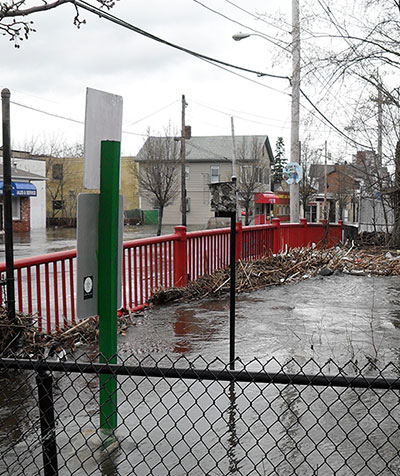Climate Resilience

Woonasquatucket River floodwater backing up behind the Valley Street bridge in Providence on March, 31 2010.
Green Infrastructure addresses both water quality and flooding, while enhancing resilience to climate impacts.
As Rhode Island experiences more intense storms resulting from climate change, we can reduce the causes while mitigating the effects of heavy rains and storm surge to our 400 plus miles of ocean-facing and bay coastline. Flooding damage is magnified as the impervious, hard surfaces of the urban and suburban landscapes prohibit water from soaking into the earth. Dry lawns, driveways, roofs, streets and highways pour stormwater into swollen rivers that are met, in hurricanes and nor’easters, by rising water of bay and ocean.
Coastlines on the Edge — Where Stormwater Meets Storm Surge
Increasingly Rhode Island is experiencing the impacts of accelerated sea level rise as extreme high tides inundate our low lying neighborhoods and roads. Along the coast where large river systems empty into the sea, flooding magnifies when stormwater runoff from a large river watershed funnels an intense rain event to meet the high tide or storm surge from the sea.
Knowledge of the combined effects of coastal hazards and local stormwater dynamics, both for rising sea levels and increased storm intensity is key to understanding what areas are appropriate for green infrastructure or gray infrastructure, and which techniques would be most effective along the coastline. Given the confluence of land and sea at the coast, it is critical to implement objectives of reducing stormwater volume and contamination from uplands and agreeing where coastal inundation and impacts will occur.
Developing resilience means acknowledging the power of water; retreating where the land will not stand up to the sea; designing buildings with inevitable sea level rise and storm surges understood; spending public money on the basis of knowledge of where the tides will rise and not where the funded projects will wash away, and protecting private interests.
Cool Cities
The sun sinks into asphalt, concrete, and brick creating heat islands, and along with other factors makes cities much warmer than farm or forest. Heat illness and mortality increase when cities do not cool down at night and when air pollutants collect at night. As heat increases so does the use of air conditioning, demanding more electricity and producing more greenhouse gases that contribute to climate change.
Using trees in stormwater-mitigation landscapes provide shade to mitigate the heat island effect as they prevent the rays of the sun from absorption in the brick and cement. Instead, during the growing season when the heat island effect adversely affects life, the sun’s energy hits foliage where it is used for photosynthesis rather than heating brick and asphalt. Obviously in cities where buildings are taller than trees, the rise above 2 or 3 stories will continue to absorb energy.